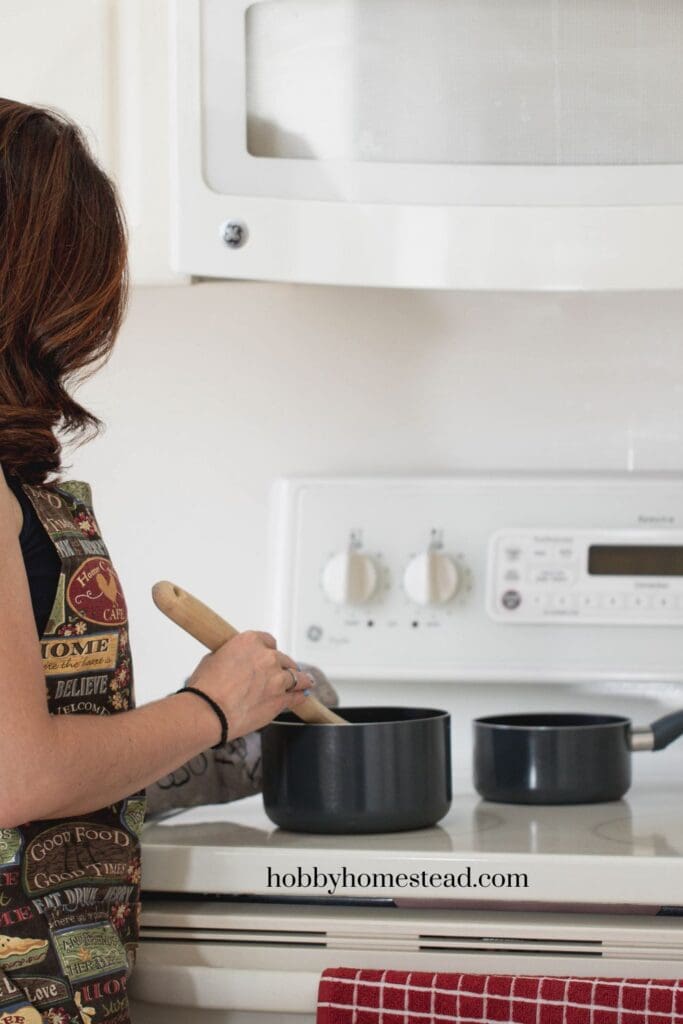Last updated on August 20th, 2024 at 09:06 pm
When life throws challenges your way, cooking from home can be a comforting and practical choice. Whether you’re facing financial constraints, health issues, or simply looking to make the most of what you have, home cooking offers a way to nourish both your body and soul.
Not only does it help you save money, but it also allows you to enjoy real foods and support your family through tough times. Embracing home cooking can transform your kitchen into a sanctuary, where traditional skills and new recipes come together to create wholesome meals.
My mom worked in restaurants cooking since she was just thirteen years old. Believe me, we had a lot of delicious food when I was growing up. Now that I have a family of my own to feed, I am right beside her in the kitchen learning these skills.

Table of contents
- Why Cooking at Home is Essential
- Meal Planning and Budgeting
- Simple and Affordable Recipes
- Cooking Tips and Tricks
- Emotional Support and Encouragement
- Use Those Leftovers in Home Cooking
- 1. Transform into New Dishes
- 2. Repurpose into Different Meals
- 3. Freeze for Later
- 4. Creative Uses for Specific Leftovers
- 5. Use Leftovers for Quick Snacks
- 6. Make a Frittata or Quiche
- 7. Incorporate Into New Recipes
- Cooking From Home is Essential for Our Family
- Have your own tips for cooking during tough times?
Why Cooking at Home is Essential
- Cost Savings: Cooking at home can be a great way to stick to a grocery budget. By preparing meals with local ingredients and seasonal vegetables, you can save money compared to eating out or buying convenience foods. For instance, using a whole chicken and stretching it into several meals is a cheap way to get the most from your grocery budget. This method is not only economical but also a fantastic way to practice homestead cooking.
- Health Benefits: Preparing meals at home allows you to control the ingredients and avoid processed foods. By focusing on real foods and homestead recipes, you can ensure your meals are healthy and nourishing. Incorporating easy recipes like soups and stews into your routine can help manage your family’s favorite holiday recipe or other cherished dishes without the added sugars and preservatives found in store-bought options.
- Emotional Comfort: Cooking can be a therapeutic activity, especially during tough times. Whether you’re trying out new recipes for the first time or using traditional skills passed down through generations, home cooking offers a sense of accomplishment and stability. It also provides an opportunity to bond with family members and create lasting memories around the table.
Meal Planning and Budgeting
- Create a Meal Plan: Developing a meal plan is an important skill for managing your grocery budget and making the most of what you have on hand. Start by planning meals around what’s on sale and incorporating seasonal ingredients. This will help you make the most of local ingredients and reduce waste.
- Budget-Friendly Ingredients: Focus on using cheap vegetables and pantry staples to create nourishing meals. Ingredients like beans, rice, and potatoes can be transformed into a variety of dishes, making them perfect for home cooks looking to stretch their grocery budget.
- Shopping Smart: Utilize farmers markets and store food wisely to maximize your savings. Look for sales and buy in bulk when possible. Keeping an eye out for deals on bulk items like flour and grains can help you save money in the long run.
Simple and Affordable Recipes
- One-Pot Meals: One-pot meals are a great way to save time and reduce cleanup. Try using an Instant Pot to make hearty dishes like stews and casseroles. These easy methods allow you to cook large batches of food with minimal effort, making them perfect for busy times.
- Batch Cooking: Batch cooking is a fantastic way to prepare meals in advance. Cook up a large batch of a staple like sourdough bread or a hearty soup, and freeze portions for later. This not only saves time but also ensures you always have a healthy meal ready to go.
- Creative Leftovers: Make the most of your leftovers by turning them into new meals. For example, roast a whole chicken and use the meat in salads, sandwiches, and soups throughout the week. This method helps stretch ingredients further and reduces food waste.

Cooking Tips and Tricks
- Make the Most of Your Pantry: Utilize your pantry staples effectively. Canned goods, grains, and dried legumes can be the basis for a variety of dishes. Learning to cook with what you have on hand is an essential kitchen skill, especially during tough times.
- Efficient Cooking Techniques: Use time-saving appliances like the Instant Pot or slow cooker to simplify meal preparation. These tools are great for making large quantities of food with minimal effort, which is ideal when you need to stretch your grocery budget.
- Freezing and Storage: Properly freezing and storing meals is a key part of maintaining a well-stocked homestead kitchen. Invest in a good set of freezer bags or containers and label them with dates to keep track of your stored food.
Emotional Support and Encouragement
- Stay Positive: Remember that cooking from home can be a source of joy and comfort. Embrace the process and use it as an opportunity to experiment with new recipes or perfect your favorite ones. Celebrate small victories, like mastering a new technique or creating a delicious meal from simple ingredients.
- Community and Sharing: Reach out to others for support and inspiration. Share your cooking experiences and recipes with friends or join online cooking groups. Connecting with others who are also focused on home cooking can provide motivation and new ideas.
Use Those Leftovers in Home Cooking
We know people that never eat leftover food, they just throw it away! We were shocked to learn that some people actually do this.
For us, using leftovers creatively can help you save time, reduce food waste, and enjoy new meals with minimal effort. Here are some great ways to use leftovers effectively.
1. Transform into New Dishes
- Soups and Stews: Turn leftover meats and vegetables into a hearty soup or stew. Just chop them up and simmer with some broth, spices, and additional veggies.
- Casseroles: Mix leftover meats, vegetables, and grains with a sauce or cheese to create a comforting casserole. Top with breadcrumbs or cheese and bake until bubbly.
- Stir-Fries: Use leftover cooked meat and vegetables in a quick stir-fry. Add some fresh vegetables and your favorite sauce for a fast and flavorful meal.
2. Repurpose into Different Meals
- Salads: Chop up leftover grilled chicken, beef, or roasted vegetables to add to salads. A quick vinaigrette or dressing will bring the dish together.
- Wraps and Sandwiches: Use leftover meats and veggies as fillings for wraps or sandwiches. Add some fresh greens, spreads, or cheeses for a satisfying lunch or snack.
- Tacos or Burritos: Fill tortillas with leftover meat, beans, and veggies to make tacos or burritos. Top with salsa, cheese, and other favorite toppings.

3. Freeze for Later
- Batch Cooking: Freeze leftovers in individual portions for easy future meals. Label and date the containers to keep track of what’s inside.
- Meal Kits: Pre-assemble ingredients for future meals. For example, freeze a mix of cooked meat and vegetables that can be quickly reheated and turned into a meal.
4. Creative Uses for Specific Leftovers
- Rice: Turn leftover rice into fried rice or rice pudding. You can also use it in soups or as a base for grain bowls.
- Pasta: Mix leftover pasta with a different sauce, or bake it into a pasta casserole. You can also turn it into a pasta salad.
- Vegetables: Roast or sauté leftover vegetables and mix them into omelets, frittatas, or grain bowls.
5. Use Leftovers for Quick Snacks
- Quesadillas: Stuff tortillas with leftover cheese, meats, or veggies, then cook until crispy for a quick snack or meal.
- Pita Pizzas: Spread leftover sauces, meats, and veggies on pita bread, top with cheese, and bake for easy mini pizzas.
6. Make a Frittata or Quiche
- Frittata: Whisk eggs with leftover meats, vegetables, and cheeses, then bake until set. It’s an easy way to use up a variety of leftovers.
- Quiche: Similar to a frittata but with a crust, quiche can be filled with a mix of leftovers, creating a delicious and versatile dish.
7. Incorporate Into New Recipes
- Smoothies: Blend leftover fruits or vegetables into smoothies. Add some yogurt or protein powder for a nutritious drink.
- Bread Crumbs: Process leftover bread into breadcrumbs to use as a coating for meats or as a topping for casseroles.
By thinking creatively and experimenting with different recipes, you can make the most out of your leftovers and reduce food waste while enjoying a variety of meals.
Cooking From Home is Essential for Our Family
Cooking from home when times get hard offers numerous benefits, from saving money to providing emotional comfort. By focusing on real foods, utilizing budget-friendly ingredients, and practicing essential kitchen skills, you can navigate tough times with resilience and creativity.
Embrace the opportunity to create nourishing meals, and remember that even small efforts in the kitchen can make a big difference.
Have your own tips for cooking during tough times?
Share your favorite easy recipes, budget-friendly ideas, or personal experiences in the comments. Let’s support each other in making cooking from home a cornerstone of our resilient and resourceful lives.


